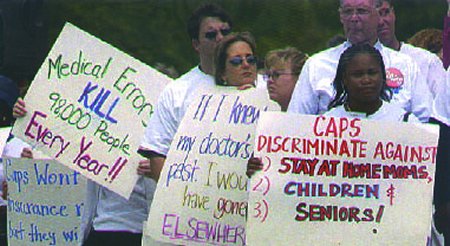|

Medical errors sparked this protest in Florida against
malpractice award limits. Some studies estimate 98,000 patient
deaths from medical errors each year.
No one expects to go to the hospital and get sicker, or even
die, but thousands of Americans do each year.
Betsy Lehman, the health
reporter for the Boston Globe, died from an overdose during
chemotherapy. Willie King, another patient cited in a study "To
Err is Human" by the Institute of Medicine (IOM), had the wrong
leg amputated. Eight-year-old Ben Kolb died during "minor
surgery" because of a drug mix-up.
More than 44,000
Americans die each year as a result of medical errors according
to conservative estimates by the IOM.
More Americans die each
year from preventable medical errors than from automobile
accidents (43,458), breast cancer (42,297) or AIDS (16,516).
Hospital errors and drug
mix-ups lead to higher costs for everyone. The IOM estimates
that injuries from medical errors add between $17 and $29
billion in total costs each year (lost income, lost household
production, disability and health care costs) with health care
costs representing more than half of the total.
Union-represented
employees can curb pressures to pay higher premiums and co-pays
by working with employers to improve the quality of care and
reduce medical errors.
"Faced with rising costs,
companies are tempted to merely pass on increased health costs
to employees and leave it at that," said IAM President Tom
Buffenbarger.
"If we insist that
employers look at the quality of the health care they are
buying, we can make it safer and more affordable for our
members," he said.
To improve health care
quality, the IAM belongs to the Leapfrog Group for Patient
Safety Standards.
Leapfrog members provide
health benefits to about 33 million Americans employed by
Fortune 500 companies and other private and public healthcare
purchasers.
"Union-negotiated health
plans are expensive and we want to ensure that our members are
getting safe, quality care," said IAM Strategic Resources
Director Steve Sleigh.
"Working with our
employers through Leapfrog and other initiatives we can better
protect our members' health and help slow down rising health
care costs."
Implementing Leapfrog's
top three patient safety recommendations dramatically reduces
medical errors and saves lives. Medication errors could be cut
by 50% if doctors were required to enter medication orders into
a computer-based system that is linked to error prevention
software.
Evidence-based hospital
referrals could cut the risk of a patient dying during surgery
and other complex medical procedures by 30%.
And deaths in Intensive
Care Units (ICUs) could be cut by 10% if ICU's were staffed by
doctors credentialed in critical care medicine. Sounds so
simple. Sounds like common sense. But, in a health care system
spinning out of control, even the simplest and most sensible
steps are difficult.
"That's why," says Steve
Sleigh, "employers and unions have a vested interest in
pressuring insurers, doctors and hospitals to improve quality.
The dollars saved can be poured back into the pockets of their
workers and investors or reinvested in new plant and equipment."
Back|Next|Cover
Story|Contents
|